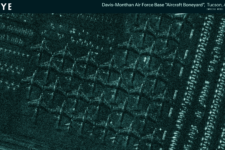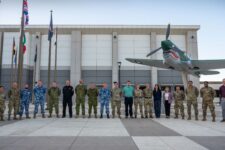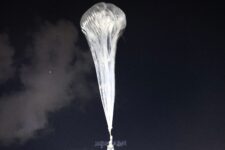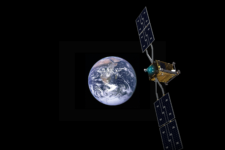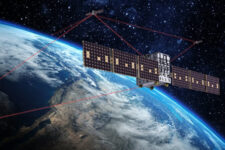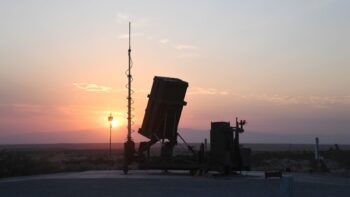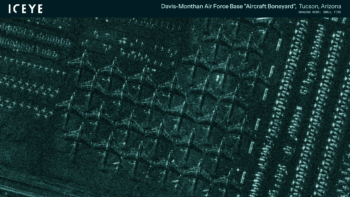
The Space Force is developing the Future Operationally Resilient Ground Evolution (FORGE) program as the ground system for the SBIRS and Next-Gen OPIR missile warning satellites. (Graphic: RTX)
WASHINGTON — The Space Force’s complex, and somewhat challenged, program to develop a new ground system for its next generation of missile warning satellites is inching forward, with four firms set to compete for development of a command and control (C2) system prototype.
NSTXL, which manages the Space Systems Command (SSC) Space Enterprise Consortium (SpEC) program, today announced awards to Ball Aerospace, Parsons, General Dynamics and Omni Federal for the Future Operationally Resilient Ground Evolution Command and Control (FORGE C2) prototype project. Each award is worth $9.75 million over 16 months, according to a NSTXL press release.
The prototype effort is designed to lay the foundation for what eventually will be a government-owned, cyber-secure satellite C2 system that will provide mission management, ground control, telemetry, tracking and command functions for two key Space Force missile warning constellations: the current Space Based Infrared System (SBIRS) and its planned replacement, the $14.4 billion Next-Generation Overhead Persistent Infrared (Next-Gen OPIR) system.
Six SBIRS satellites are now on orbit, with four in geosynchronous Earth orbit (GEO) and two in polar orbit. Next-Gen OPIR will have two satellites in GEO — if Congress approves the Space Forces plan to drop one of the three originally planned — and two in polar orbit. The first Next-Gen OPIR satellite was supposed to launch in 2025, but according to a June report [PDF] by the Government Accountability Office is likely to be delayed at least a year.
Which, in some ways, may be good for the Space Force considering that there also have been some troubles with the FORGE ground system effort, which is being developed to support both SBIRS and Next-Gen OPIR. GAO’s June report on Pentagon acquisition efforts also noted that key pieces of the FORGE effort critical to Next-Gen OPIR operations are not likely to be available until after 2025 — putting FORGE on a collision course with Air Force space acquisition czar Frank Calvelli, who has resolved the long-standing problem of Pentagon satellites becoming operational years before ground equipment needed to use them.
SSC has broken down the FORGE program, which Space Force fiscal 2024 budget documents say will cost a total of $2.4 billion, into a number of different “thrusts.” These include:
- FORGE C2, designed to produce a minimum capability in Phase 1 with a downselect expected in February 2025. Future phases then would add capability, the NSTXL release explained.
- Next-Gen Interim Operations (NIO), an interim C2 solution that originally was conceived as a “risk reduction” effort in case FORGE C2 fell behind the planned Next-Gen OPIR launch schedule, according to the GAO report. However, NIO has now been designated as part of what the Space Force FY24 budget documents call “Next-Gen Transition” thrust, and will serve as “the baseline ground system to provide command and control capabilities for launch, early on-orbit testing, and initial operations of the Next Gen OPIR satellites,” GAO explains. Lockheed Martin is developing NIO as part of its contracts, worth a combined $7.8 billion, for development and production of the Next-Gen OPIR GEO satellites.
- FORGE Mission Data Processing Application Framework (MDPAF), the open-source, software-centric backbone for collecting and processing data from SBIRS and Next-Gen OPIR satellites, then generating warnings and alerts to commanders. RTX (formerly Raytheon) won a five-year, $197 million contract in 2020 to develop the open-source, software-centric data processing platform — which the company asserts will in future be able to pull data from any satellite, and thus support the Defense Department’s overarching Joint All Domain Command and Control (JADC2) network-of-networks.
- Relay Ground Stations, which moves data collected by the satellites to ground entry points where it can be routed to warfighters. Space Force FY24 budget documents show that there are two new sites currently planned for these stations — one in Asia and one in Europe — as well as upgrades to old stations now being used by SBIRS.
- E-FORGE, a new start in FY24, according to Space Force budget documents, which “will begin initial studies/prototyping needed for the development of a survivable mobile antenna system and mobile shelters. Additionally, E-FORGE will begin development of a mobile data processing platform to include mission unique software that will support the survivable endurable architecture.”







